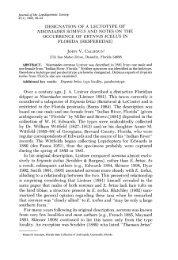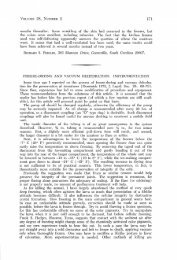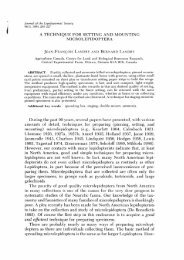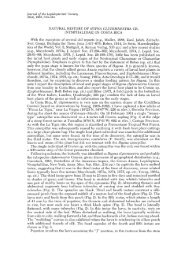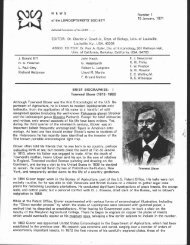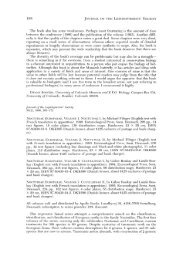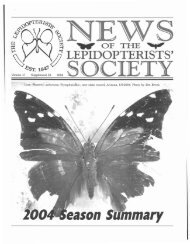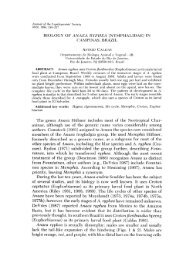HOW TO MAKE REGIONAL LISTS OF BUTTERFLIES - Yale University
HOW TO MAKE REGIONAL LISTS OF BUTTERFLIES - Yale University
HOW TO MAKE REGIONAL LISTS OF BUTTERFLIES - Yale University
Create successful ePaper yourself
Turn your PDF publications into a flip-book with our unique Google optimized e-Paper software.
VOLUME 33, NUMBER 4 227ful, particularly when visits to the area are at weekly or greater intervals,because they give a valuable clue to how long the species hasbeen flying. I use a series of five lower case letters: a, perfect andunblemished; b, showing slight wear; c, definitely worn; d, extremelyworn; and e, a complete rag, the wings so rubbed that identificationmay be difficult. The important thing in this scale is wingwear, and it increases with age, so record tears in the wings separately.A tear (or bird or lizard bite) can happen in a fresh specimen andmeans little in this connection. Remember, you are using the scale toestimate the relative age of the individual since eclosion, not to describean exchange item! When you see a number of individuals of aspecies on a particular day your notes might read, "all a" (suggestingquite recent emergence), or "b-d, most c" (suggesting about themidpoint of the flight period or a little later), or "most d, one a"(suggesting a second flight beginning as an earlier flight is ending),and so on.Words like "common" or "scarce" convey a poor idea of numbers;mark-recapture techniques can give accurate population figures, butthe procedure is far too time-consuming for routine use. Some yearsago I devised a compromise system, more accurate and objective thanwords, less tedious than population estimation; it is easily used, assubsequent experience with it has shown. This abundance measureis a logarithmic scale much like that of stellar magnitudes used inastronomy, after which it was patterned. The scale records numbersseen per hour, or the equivalent, as follows:Scaleo12345678Numbers125-625 individuals seen per hour25-125 /I /I /I5- 25 /I /I1- 5 /I /I /I0.2- 1 per hour, or 1 seen per 1-5 hours1 per 5-25 hours1 per 25-125 hours1 per 125-625 hours1 per 625-3,125 hoursThe scale can be extended in either direction if needed (it rarely willbe): -1 would be the next commoner scale unit, and so on. Eachabundance unit represents 1/5 the abundance of the preceding unit,and a difference of one unit is about the minimum that can be accuratelyperceived in routine observation.




